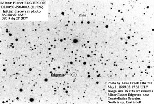An amateur astronomer in Nebraska last month officially named an asteroid after fellow Nebraskan and MIT legend Harold "Doc" Edgerton.
On May 1, 1998, Robert Linderholm inadvertently photographed Asteroid Edgerton while he was taking images of Pluto at Lime Creek 721, a backyard amateur observatory in the southwest corner of Nebraska.
The site consists of an outdoor mounted telescope and camera cabled to a computer, where the telescope direction is controlled and images are downloaded.
As Linderholm attempted to measure Pluto's motion by taking sequential images, which are then compared to see if any object seems to be moving relative to the stellar background, "Edgerton showed up just a few arc minutes below Pluto," he said.
The object was assigned the temporary designation of 1998 JA by the Minor Planet Center at the Smithsonian Astrophysical Observatory in Cambridge, the world's repository for planet data.
"Asteroid Edgerton has actually been measured by others several times over the past 20 to 30 years," Linderholm wrote in an e-mail. "However, data were insufficient to establish acceptable orbital elements. My measurements on May 1, 1998, and subsequent other new measurements by myself and other observatories provided the principle orbital elements. Consequently, the discovery was attributed to me." Linderholm has 10 discoveries to date, of which four have been named.
It takes many years for an initial observation to become a "discovery," he said, because it takes a lot of observations (87 in the case of Edgerton) to determine the orbit.
After its orbit was nailed down, the asteroid was assigned a permanent number, which allowed the discoverer to name it. The name Edgerton was published by the Minor Planet Center on July 5.
NEBRASKAN STARS
"Doc" Edgerton was an engineer and inventor. Creator of the stroboscope and electronic flash, he is best known for his stop-action photographs, his most famous being a closeup of a falling drop of milk. Edgerton, Institute Professor emeritus of electrical engineering, died in 1990.
"The reason I chose the name Edgerton is that Harold "Doc" Edgerton was a Nebraskan and I have named other discoveries for Nebraska notables," Linderholm said. Other of Linderholm's asteroids are named for author Willa Cather and the state of Nebraska itself.
Linderholm said thousands of asteroids have been located by amateur and research observatories in the past five years because of more intensive searches for potentially hazardous asteroids and recent advances in asteroid-tracking equipment and software.
Asteroid Edgerton, a "main belt" asteroid orbiting the sun between Mars and Jupiter, is probably around five miles in diameter. Linderholm said it does not threaten the Earth with its orbit.
"Congratulations on your wonderful discovery," James Bales, assistant director of the Edgerton Center on the MIT campus, wrote to Linderholm. "I've sent your note to Bob Edgerton [Doc's son, who lives in Seattle], who will be delighted to hear of it."
A version of this article appeared in MIT Tech Talk on August 15, 2001.






